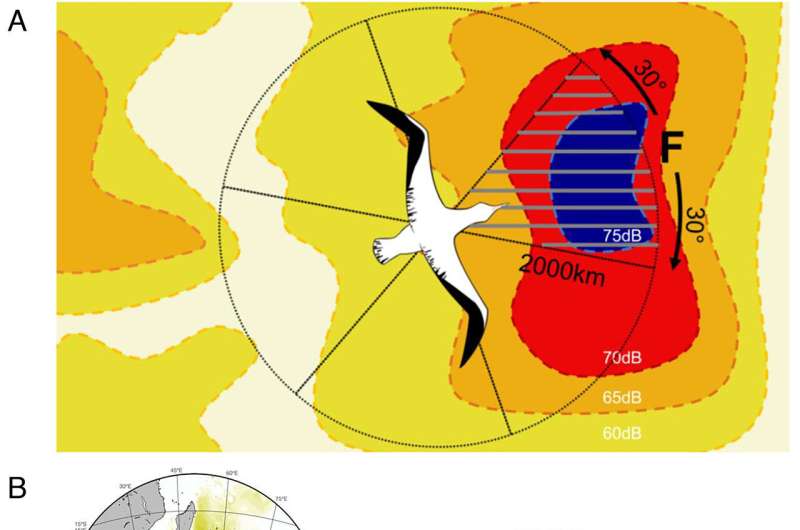This article has been reviewed according to Science X's editorial process and policies. Editors have highlighted the following attributes while ensuring the content's credibility:
fact-checked
peer-reviewed publication
trusted source
proofread
First evidence that albatrosses use infrasound to navigate long journeys

A new study by the University of Liverpool provides the first evidence that wandering albatrosses, one of the widest-ranging seabirds, may use infrasound to help them navigate long and featureless foraging trips covering thousands of miles.
In a paper published in the journal Proceedings of the National Academy of Sciences (PNAS), researchers from the University's School of Environmental Sciences show that albatrosses orientate towards areas of "loud" microbarom infrasound when flying on long distance foraging trips. The paper is titled "Albatross movement suggests sensitivity to infrasound cues at sea."
Infrasound is a form of low-frequency sound that is inaudible to humans but is ubiquitous in the marine environment. Microbaroms are a type of infrasound associated with colliding ocean waves. Such wavy areas are also associated with strong winds, which albatrosses depend on to help them fly efficiently.
The researchers used GPS trackers to determine the flight paths of 89 wandering albatrosses breeding in the Crozet Islands archipelago, Southern Ocean, over the course of their foraging trips to sea, which can last up to a month.
They then compared these flight paths to modeled acoustic maps that the team had developed to represent the distribution of microbarom infrasound.
This revealed that wandering albatrosses orientate towards areas of "loud" microbarom infrasound when departing on bouts of directed flight, suggesting that they may perceive and respond to microbarom infrasound propagated over long distances.
Dr. Natasha Gillies, a seabird ecologist with the University's School of Environmental Sciences who jointly led the study with Dr. Lucía Martín López, said, "How animals navigate and search for resources over large spatial scales exceeding 100s–1,000s km is a fundamental question in ecology.
"For marine animals, such as seabirds, this question is especially intriguing due to the limited availability of visual information, meaning that other cues must be involved in movement.
"It has been proposed that seabirds could use infrasound to help them navigate the huge expanses of featureless ocean environment that they fly over in order to forage.
"Our results offer the first evidence for responsiveness to infrasound in a movement context for a free-ranging animal."
The study forms part of a Human Frontier Science Program grant, which brings together a team of international collaborators (Stellenbosch University, South Africa; University of Florida, U.S.; Royal Netherlands Meteorological Institute, the Netherlands).
This is the first empirical test of their previous proposal that infrasound could be an important cue for seabird navigation.
Dr. Samantha Patrick, who led the grant, said, "It is only through interdisciplinary science like this, which brings together scientists across diverse fields, that we can achieve such new and exciting insights."
More information: Natasha Gillies et al, Albatross movement suggests sensitivity to infrasound cues at sea, Proceedings of the National Academy of Sciences (2023). DOI: 10.1073/pnas.2218679120
Journal information: Proceedings of the National Academy of Sciences
Provided by University of Liverpool


















